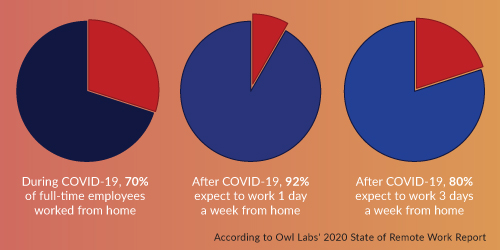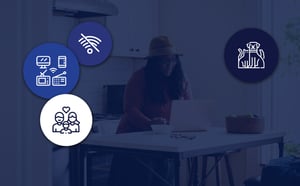Working from home has become the new normal. That's due, in part, to COVID-19. It has upended how we work. Companies that hadn't considered remote work seriously had to change their opinions. While some struggled - many having to face closure - others thrived. However, this new normal has also brought new distractions that we wouldn’t have considered without first working from home permanently.
In this piece, we touch on a few of those ‘WFH distractions’, exploring how our team at DotActiv found innovative and effective ways to beat them back. It’s also worth looking at a few of the interesting statistics that show that working remotely is here to stay.

Owls Labs, in collaboration with Global Workforce Analysis, surveyed over 2000 full-time workers in the United States for its 2020 State of Remote Work report.
According to the report, nearly 70% of full-time workers worked from home during COVID-19. Of those surveyed, 92% expected to work from home at least once a week after COVID-19. 80% wanted to work at home three times a week after COVID-19.
Considering these numbers, it’s rational to conclude that we’re now living in a world where fully remote work or a hybrid version is here to stay. Instead of fighting this new reality, perhaps it’s worth looking at how to embrace remote work and find new ways to get the most out of our home-bound workdays. That includes dealing with any potential distractions so that you can remain productive throughout the day.

Struggling with load shedding: How to deal with it
If you live in South Africa, load shedding has become as normal as working from home. That’s not to be glib about the seriousness of the issue - it's a frustrating experience and often happens at the most inconvenient times.
However, as with any issue, if you can expect (and plan for) it, you’re in a better position to know how to deal with it.
Load shedding is an action taken to temporarily reduce the supply of electricity to an area to avoid overloading and/or breaking the entire system.
It’s worth pointing out that South Africa isn’t the only country that struggles with electricity cut-offs. At the time of publication, Australians in Queensland and New South Wales were warned to expect blackouts.
That aside, how does DotActiv’s staff deal with it?
When we started working from home in mid-2020 due to the initial COVID-19 hard lockdown, many of us purchased a battery backup, mini UPS and/or generator. Considering South Africa experienced rolling blackouts before the pandemic, most households were already kitted out.
No matter if it was a generator, a battery backup or a UPS, we were able to remain connected to the internet through the work day, which meant little to no downtime. It helps that we have tried and tested processes, which we’ve refined further since the beginning of the Coronavirus pandemic.
It all leads to the point that we are fully confident in our ability to deliver work, remotely, to the same standard as if we were working alongside each other, for our clients, from the office.

Looking after your pets: How do deal with them
Loneliness and feelings of isolation have been common symptoms associated with working from home. That was especially true in the early days of the pandemic when we couldn’t leave our homes.
According to Buffer’s 2020 State of Remote Work report, alongside difficulties with collaboration and communication, loneliness was a top struggle for remote workers.
It remains true, even today when we can leave our homes again. Fortunately, we have our pets to keep us company. Speak to anyone who works at DotActiv and the vast majority will say that it's one of the positives of working at home. Who doesn’t like getting up from their desk to hug their dog or cat (or pet rat)?
That, of course, means that your pets can quickly become a distraction.
It’s hard to say no when your basset hound wants its belly rubbed and flops down right in front of you and gives you those puppy dog eyes. Or when your Maine Coon walks over your keyboard during an online meeting, demanding that you give it food or it won’t move.
It can be difficult to stop your pets from trying to get your attention. One way to curb it so that your beloved fur babies are not a big distraction is to create a comfy and cosy area in your house. It could be in the same room as your workspace - they might just want to be near you - or in a room next door if you’re in a meeting.
Alternatively, you can set specific times during the day when you pay them attention. Could be during a 15-minute coffee break every two hours, for example. This is also an excellent opportunity for you to take a set break during the day.
If you can get them settled, it’s far easier for you to get back to your work and then concentrate.

Addicted to social media: How to combat it
Social media and mobile phones are two of the top work distractions and productivity killers. You could argue it’s the same no matter if you work in an office or from home. Working remotely exacerbates the problem, or, at least, opens up the opportunity for staff to take more chances on browsing their phones when they should be focused on their tasks.
According to a WFH survey conducted by OfficeNeedle, mobile phones (56.1%) and social media (43.9%) are the two biggest distractions while working from home.
One way to approach this WFH distraction is to set aside specific times that you’ll check your social media or phone. In the case of checking your phone, we’re only referring to non-work-related instances.
You can use the Pomodoro technique. If you have never heard of it, it’s a time management technique that’s effective at helping you to avoid distractions. You’d alternate work sessions with frequent, short breaks to sustain your concentration.
In the case of social media, for example, you can set the timer for, say, 45 minutes. This period you choose is known as a Pomodoro.
During those 45 minutes, you can focus on a specific task or piece of work that is on your to-do list for the day. Then, once that 45 minutes is up, you can take a 15-minute breather where you can stand up and stretch your legs, get a cup of coffee, cuddle your dog or check social media.
Once those 15 minutes are up, it's back into another 45 minutes of focus. There is the argument that your work sprints should be 25 minutes long and your short breaks only 5 minutes. Then after four ‘Pomodoros’, you take a 15 to 30-minute break.
If this technique isn’t enough, you can supplement it by downloading an appropriate app that will limit your access to social media during the day.
Better still, try giving social media up altogether - though that’s easier said than done!

Family matters: How to manage it
Working from home has tipped the work-life balance to the point where it can often be difficult to get it right. In the past, it was easy - you kept your work at work during work hours and then went home to relax and re-energise.
It’s a little trickier when you work and live in the same space. That’s true, even if you have a separate office space on the other side of the house.
Airtasker surveyed over a thousand full-time employees across the U.S., half of which worked remotely. It found that 29% of remote workers struggled to find a proper work-life balance compared to 23% of office employees.
There are also distractions from your family and everyday life - and you can’t shut them out. While the odd distraction isn’t a problem, it can become a major concern when you see it’s affecting your productivity.
So how do we at DotActiv deal with this successfully? It comes down to clear communication. That could mean doing any of the following:
- Sharing your weekly calendar with them: They know when you’re in meetings and not to be disturbed.
- Setting up specific quiet times: This could coincide with the Pomodoro Technique mentioned above (click here to read about it again) where you set aside specific time to chat with them during the day.
- Putting up a do not disturb sign: You can place a sign on the door to your workspace so that anyone knows when it’s not a good idea to disturb you. That also includes when you’re not in meetings and want to focus.
Setting up these boundaries helps you in two ways:
Firstly, you can focus on your work, ensuring that you get as much as possible done by the end of your work day. Secondly, you can develop a better work-life balance.
By focusing exclusively on work during your work hours and minimising your distractions, it means when the time comes for home life, you can focus on that and not worry about work. It’s also important to make plans for your after-work hours to balance your work fatigue.
Conclusion
It’s been two years since COVID-19 has changed the way DotActiv (and the world) approaches work. During that time, we experienced what it’s like to work remotely. While many of our employees have since returned to their various offices - others still work from home.
That means we all still deal with many of the above distractions. However, the key is that we know how to deal with these distractions effectively. You only need to talk to anyone in the company - 2022 is the year where we are planning on expanding and taking the company to the next level.
Are you interested in joining the DotActiv team and providing category management solutions to retailers and suppliers from across the world? We’d love to hear from you. You can read up about DotActiv, what we stand for and how we operate here or apply for any open positions here.



COMMENTS